Improving the Representation of Whitecap Fraction and Sea Salt Aerosol Emissions in the ECMWF IFS-AER
Abstract
:1. Introduction
2. Models and Data
2.1. Main Characteristics of IFS-AER
2.2. Sea Salt Aerosol Emission Schemes in the IFS-AER
2.2.1. First Sea Salt Emission Scheme: Monahan et al. (1986)
2.2.2. Recent Sea Salt Emission Scheme: Grythe et al. (2014)
2.2.3. New Sea Salt Emission Schemes: Albert et al. (2016)
2.3. Data for Evaluating Sea Salt Emission Schemes
2.3.1. Whitecap Fraction
2.3.2. Surface Concentration of Sea Salt Aerosol
2.3.3. Aerosol Optical Depth
3. Results: Simulations and Evaluation
3.1. Experiments
3.2. Budgets
3.3. Evaluation of the Simulated Whitecap Fraction
3.4. Evaluation of the Simulated Sea Salt Aerosol Surface Concentration
3.5. Evaluation of the Simulated Aerosol Optical Depth
4. Discussion
4.1. IFS-AER Performance with Different Sea Salt Emission Schemes
4.2. Validity of Whitecap Fraction from Satellite Observations
4.3. On Scaling and Shape Factors of Sea Spray Generation Function
5. Conclusions
Author Contributions
Funding
Institutional Review Board Statement
Informed Consent Statement
Data Availability Statement
Conflicts of Interest
Abbreviations
| Acronyms | |
| AEROCE | Atmosphere/Ocean Chemistry Experiment |
| AERONET | Aerosol Robotic Network |
| AOD | Aerosol Optical Depth |
| CAMS | Copernicus Atmosphere Monitoring Service |
| CASTNET | Clean Air Status and Trends Network |
| CB05 | Carbon Bond Mechanism 5 (a chemistry scheme) |
| CYxxRn (xxRn) | Implementation cycle of ECMWF’s IFS |
| ECMWF | European Centre for Medium-Range Weather Forecasts |
| FMI | Finnish Meteorological Institute |
| GDAS | Global Data Assimilation System |
| GEMS | Global and regional Earth-system Monitoring using Satellite and in situ data |
| GHz | GigaHertz |
| IFS | Integrated Forecasting System |
| IFS-AER | Integrated Forecasting System aerosol module |
| IFS-CB05 | Integrated Forecasting System chemistry module |
| LOA | Laboratoire d’Optique Atmosphérique |
| LMD | Laboratoire de Météorologie Dynamique |
| LOA/LMDZ | The general circulation model of LOA and LMD |
| MACC | Monitoring Atmospheric Composition and Climate, series II and III |
| NA | Not applicable (not available) |
| NCEP | U. S. National Center for Environmental Prediction |
| QuikSCAT | Quick Scatterometer |
| SEAREX | Sea/Air Exchange |
| SSSF | Sea Spray Source Function |
| SST | Sea Surface Temperature |
| Abbreviations | |
| A16 | Albert et al. (2016) and sea salt emission scheme based on it |
| A16E | Sea salt emission scheme with Extended size range of applicability |
| G14 | Grythe et al. (2014) and the sea salt emission scheme based on it |
| M86 | Monahan et al. (1986) and the sea salt emission scheme based on it |
| M80 | Monahan and O’Muircheartaigh (1980) |
| MetOc | Meteorological and oceanographic |
| Cl− | Chlorine ion |
| Na+ | Sodium ion |
| PM10 | Particulate Matter with particle size less than 10 µm |
| RH | Relative Humidity |
| Variables | |
| A | Expression (10) used in (9) |
| a, b | Regression coefficients in (7) |
| , | Regression coefficients in (8) |
| B | Expressions (3) and (10) used in (2) and (9), respectively |
| Dry particle diameter | |
| Sea spray production flux | |
| i-th forecast | |
| i-th observation | |
| Function of forcing parameters representing the scaling factor (magnitude) in SSSF | |
| Function of particle radius at RH = 80% representing the shape factor (size distribution) in SSSF | |
| FGE | Fractional Gross Error |
| MNMB | Modified Normalized Mean Bias |
| RMSE | Root-mean-square error |
| N | Number of samples in a population |
| r | Correlation coefficient |
| Particle radius at formation (RH = 100%) | |
| Particle radius at RH of 80% | |
| Dry particle radius (RH = 0%) | |
| SS | Surface concentration of sea salt aerosols |
| T | Sea surface temperature |
| Brightness Temperature | |
| Scaling factor in emission scheme G14 | |
| Wind speed at 10 m reference height | |
| W | Whitecap fraction |
| Wind speed dependence of whitecap fraction | |
| Whitecap fraction retrievals from satellite brightness temperature | |
| Adjustable parameter in expression A |
References
- Inness, A.; Ades, M.; Agustí-Panareda, A.; Barré, J.; Benedictow, A.; Blechschmidt, A.M.; Dominguez, J.J.; Engelen, R.; Eskes, H.; Flemming, J.; et al. The CAMS reanalysis of atmospheric composition. Atmos. Chem. Phys. 2019, 19, 3515–3556. [Google Scholar] [CrossRef]
- Hollingsworth, A.; Engelen, R.J.; Textor, C.; Benedetti, A.; Boucher, O.; Chevallier, F.; Dethof, A.; Elbern, H.; Eskes, H.; Flemming, J.; et al. Toward a Monitoring and Forecasting System For Atmospheric Composition: The GEMS Project. Bull. Am. Meteorol. Soc. 2008, 89, 1147–1164. [Google Scholar] [CrossRef]
- Morcrette, J.J.; Boucher, O.; Jones, L.; Salmond, D.; Bechtold, P.; Beljaars, A.; Benedetti, A.; Bonet, A.; Kaiser, J.; Razinger, M.; et al. Aerosol analysis and forecast in the European Centre for medium-range weather forecasts integrated forecast system: Forward modeling. J. Geophys. Res. Atmos. 2009, 114, D06206. [Google Scholar] [CrossRef]
- Benedetti, A.; Morcrette, J.J.; Boucher, O.; Dethof, A.; Engelen, R.; Fisher, M.; Flentje, H.; Huneeus, N.; Jones, L.; Kaiser, J.; et al. Aerosol analysis and forecast in the European centre for medium-range weather forecasts integrated forecast system: 2. Data assimilation. J. Geophys. Res. Atmos. 2009, 114, D13205. [Google Scholar] [CrossRef]
- Rémy, S.; Kipling, Z.; Flemming, J.; Boucher, O.; Nabat, P.; Michou, M.; Bozzo, A.; Ades, M.; Huijnen, V.; Benedetti, A.; et al. Description and evaluation of the tropospheric aerosol scheme in the European Centre for Medium-Range Weather Forecasts (ECMWF) Integrated Forecasting System (IFS-AER, cycle 45R1). Geosci. Model Dev. 2019, 12, 4627–4659. [Google Scholar] [CrossRef]
- Engelen, R.J.; Serrar, S.; Chevallier, F. Four-dimensional data assimilation of atmospheric CO2 using AIRS observations. J. Geophys. Res. Atmos. 2009, 114. [Google Scholar] [CrossRef]
- Agustí-Panareda, A.; Massart, S.; Chevallier, F.; Boussetta, S.; Balsamo, G.; Beljaars, A.; Ciais, P.; Deutscher, N.M.; Engelen, R.; Jones, L.; et al. Forecasting global atmospheric CO2. Atmos. Chem. Phys. 2014, 14, 11959–11983. [Google Scholar] [CrossRef]
- Flemming, J.; Inness, A.; Flentje, H.; Huijnen, V.; Moinat, P.; Schultz, M.G.; Stein, O. Coupling global chemistry transport models to ECMWF’s integrated forecast system. Geosci. Model Dev. 2009, 2, 253–265. [Google Scholar] [CrossRef]
- Flemming, J.; Huijnen, V.; Arteta, J.; Bechtold, P.; Beljaars, A.; Blechschmidt, A.M.; Diamantakis, M.; Engelen, R.J.; Gaudel, A.; Inness, A.; et al. Tropospheric chemistry in the Integrated Forecasting System of ECMWF. Geosci. Model Dev. 2015, 8, 975–1003. [Google Scholar] [CrossRef]
- Huijnen, V.; Flemming, J.; Chabrillat, S.; Errera, Q.; Christophe, Y.; Blechschmidt, A.M.; Richter, A.; Eskes, H. C-IFS-CB05-BASCOE: Stratospheric chemistry in the Integrated Forecasting System of ECMWF. Geosci. Model Dev. 2016, 9, 3071–3091. [Google Scholar] [CrossRef]
- de Leeuw, G.; Andreas, E.L.; Anguelova, M.D.; Fairall, C.W.; Lewis, E.R.; O’Dowd, C.D.; Schulz, M.; Schwartz, S.E. Production flux of sea-spray aerosol. Rev. Geophys. 2011, 49, RG2001. [Google Scholar] [CrossRef]
- Boucher, O.; Pham, M.; Venkataraman, C. Simulation of the atmospheric sulfur cycle in the Laboratoire de Meteorologie Dynamique general circulation model: Model description, model evaluation, and global and European budgets. Note Sci. L’IPSL 2002, 23, 27. [Google Scholar]
- Reddy, M.S.; Boucher, O.; Bellouin, N.; Schulz, M.; Balkanski, Y.; Dufresne, J.L.; Pham, M. Estimates of global multicomponent aerosol optical depth and direct radiative perturbation in the Laboratoire de Météorologie Dynamique general circulation model. J. Geophys. Res. 2005, 110, D10S16. [Google Scholar] [CrossRef]
- Yarwood, G.; Rao, S.; Yocke, M.; Whitten, G. Updates to the Carbon Bond Chemical Mechanism: CB05. Final Report to the US EPA. EPA Report Number: RT-0400675. 2005. Available online: http://www.camx.com (accessed on 3 April 2019).
- Huijnen, V.; Pozzer, A.; Arteta, J.; Brasseur, G.; Bouarar, I.; Chabrillat, S.; Christophe, Y.; Doumbia, T.; Flemming, J.; Guth, J.; et al. Quantifying uncertainties due to chemistry modelling—Evaluation of tropospheric composition simulations in the CAMS model (cycle 43R1). Geosci. Model Dev. 2019, 12, 1725–1752. [Google Scholar] [CrossRef]
- Remy, S.; Kipling, Z.; Huijnen, V.; Flemming, J.; Nabat, P.; Michou, M.; Ades, M.; Engelen, R.; Peuch, V.H. Description and evaluation of the tropospheric aerosol scheme in the Integrated Forecasting System (IFS-AER, cycle 47R1) of ECMWF. Geosci. Model Dev. Discuss. 2021. in review. [Google Scholar] [CrossRef]
- Jaeglé, L.; Quinn, P.K.; Bates, T.S.; Alexander, B.; Lin, J.T. Global distribution of sea salt aerosols: New constraints from in situ and remote sensing observations. Atmos. Chem. Phys. 2011, 11, 3137–3157. [Google Scholar] [CrossRef]
- Anguelova, M.D.; Webster, F. Whitecap coverage from satellite measurements: A first step toward modeling the variability of oceanic whitecaps. J. Geophys. Res 2006, 111, C03017. [Google Scholar] [CrossRef]
- Grythe, H.; Ström, J.; Krejci, R.; Quinn, P.; Stohl, A. A review of sea-spray aerosol source functions using a large global set of sea salt aerosol concentration measurements. Atmos. Chem. Phys. 2014, 14, 1277–1297. [Google Scholar] [CrossRef]
- Monahan, E.C.; Spiel, D.E.; Davidson, K.L. A model of marine aerosol generation via whitecaps and wave disruption. In Oceanic Whitecaps and Their Role in Air–Sea Exchange Processes; Monahan, E.C., MacNiocaill, G., Eds.; D. Reidel: Dordrecht, The Netherlands, 1986; pp. 167–174. [Google Scholar]
- Monahan, E.C.; Muircheartaigh, I.O. Optimal power-law description of oceanic whitecap coverage dependence on wind speed. J. Phys. Oceanogr. 1980, 10, 2094–2099. [Google Scholar] [CrossRef]
- Sofiev, M.; Soares, J.; Prank, M.; de Leeuw, G.; Kukkonen, J. A regional-to-global model of emission and transport of sea salt particles in the atmosphere. J. Geophys. Res. Atmos. 2011, 116. [Google Scholar] [CrossRef]
- Albert, M.F.M.A.; Anguelova, M.D.; Manders, A.M.M.; Schaap, M.; de Leeuw, G. Parameterization of oceanic whitecap fraction based on satellite observations. Atmos. Chem. Phys. 2016, 16, 13725–13751. [Google Scholar] [CrossRef]
- Salisbury, D.J.; Anguelova, M.D.; Brooks, I.M. Global distribution and seasonal dependence of satellite-based whitecap fraction. Geophys. Res. Lett. 2014, 41, 1616–1623. [Google Scholar] [CrossRef]
- Gong, S. A parameterization of sea-salt aerosol source function for sub- and super-micron particles. Glob. Biogeochem. Cycles 2003, 17, 1097. [Google Scholar] [CrossRef]
- O’Dowd, C.; Smith, M.; Consterdine, I.; Lowe, J. Marine aerosol, sea-salt, and the marine sulphur cycle: A short review. Atmos. Environ. 1997, 31, 73–80. [Google Scholar] [CrossRef]
- Anguelova, M.D.; Bettenhausen, M.H. Whitecap fraction from satellite measurements: Algorithm description. J. Geophys. Res. Ocean. 2010, 124, 1827–1857. [Google Scholar] [CrossRef]
- Soares, J.; Sofiev, M.; Geels, C.; Christensen, J.H.; Andersson, C.; Tsyro, S.; Langner, J. Impact of climate change on the production and transport of sea salt aerosol on European seas. Atmos. Chem. Phys. 2016, 16, 13081–13104. [Google Scholar] [CrossRef]
- Rvan Loon, M.; Tarrasón, L.; Posch, M. Modelling Base Cations in Europe; Technical Report MSC-W; Norwegian Meteorological Institute: Oslo, Norway, 2005. [Google Scholar]
- Bozzo, A.; Benedetti, A.; Flemming, J.; Kipling, Z.; Remy, S. An aerosol climatology based on the ECMWF-Copernicus Atmosphere Monitoring Service aerosol model: Application to the ECMWF Forecasting system. Geosci. Model Dev. 2020, 13, 1007–1034. [Google Scholar] [CrossRef]
- Holben, B.N.; Eck, T.F.; Slutsker, I.; Tanre, D.; Buis, J.P.; Setzer, A.; Vermote, E.; Reagan, J.A.; Kaufman, Y.; Nakajima, T.; et al. AERONET—A federated instrument network and data archive for aerosol characterization. Remote Sens. Environ. 1998, 66, 1–16. [Google Scholar] [CrossRef]
- Sogacheva, L.; Popp, T.; Sayer, A.M.; Dubovik, O.; Garay, M.J.; Heckel, A.; Hsu, N.C.; Jethva, H.; Kahn, R.A.; Kolmonen, P.; et al. Merging regional and global aerosol optical depth records from major available satellite products. Atmos. Chem. Phys. 2020, 20, 2031–2056. [Google Scholar] [CrossRef]
- Luo, G.; Yu, F.; Schwab, J. Revised treatment of wet scavenging processes dramatically improves GEOS-Chem 12.0.0 simulations of surface nitric acid, nitrate, and ammonium over the United States. Geosci. Model Dev. 2019, 12, 3439–3447. [Google Scholar] [CrossRef]
- Zhang, L.; He, Z. Technical Note: An empirical algorithm estimating dry deposition velocity of fine, coarse and giant particles. Atmos. Chem. Phys. 2014, 14, 3727–3729. [Google Scholar] [CrossRef]
- Loew, A.; Bell, W.; Brocca, L.; Bulgin, C.E.; Burdanowitz, J.; Calbet, X.; Donner, R.V.; Ghent, D.; Gruber, A.; Kaminski, T.; et al. Validation practices for satellite-based Earth observation data across communities. Rev. Geophys. 2017, 55, 779–817. [Google Scholar] [CrossRef]
- Wu, J. Variations of whitecap coverage with wind stress and water temperature. J. Phys. Oceanogr. 1988, 18, 1448–1453. [Google Scholar] [CrossRef]
- Hooker, G.; Brumer, S.; Zappa, C.; Monahan, E. Inferences to Be Drawn from a Consideration of Power-Law Descriptions of Multiple Data Sets Each Comprised of Whitecap Coverage, WB, and 10-m Elevation Wind Speed Measurements (U10). In Recent Advances in the Study of Oceanic Whitecaps; Springer: Cham, Switzerland, 2020; Chapter 4; pp. 43–63. [Google Scholar]


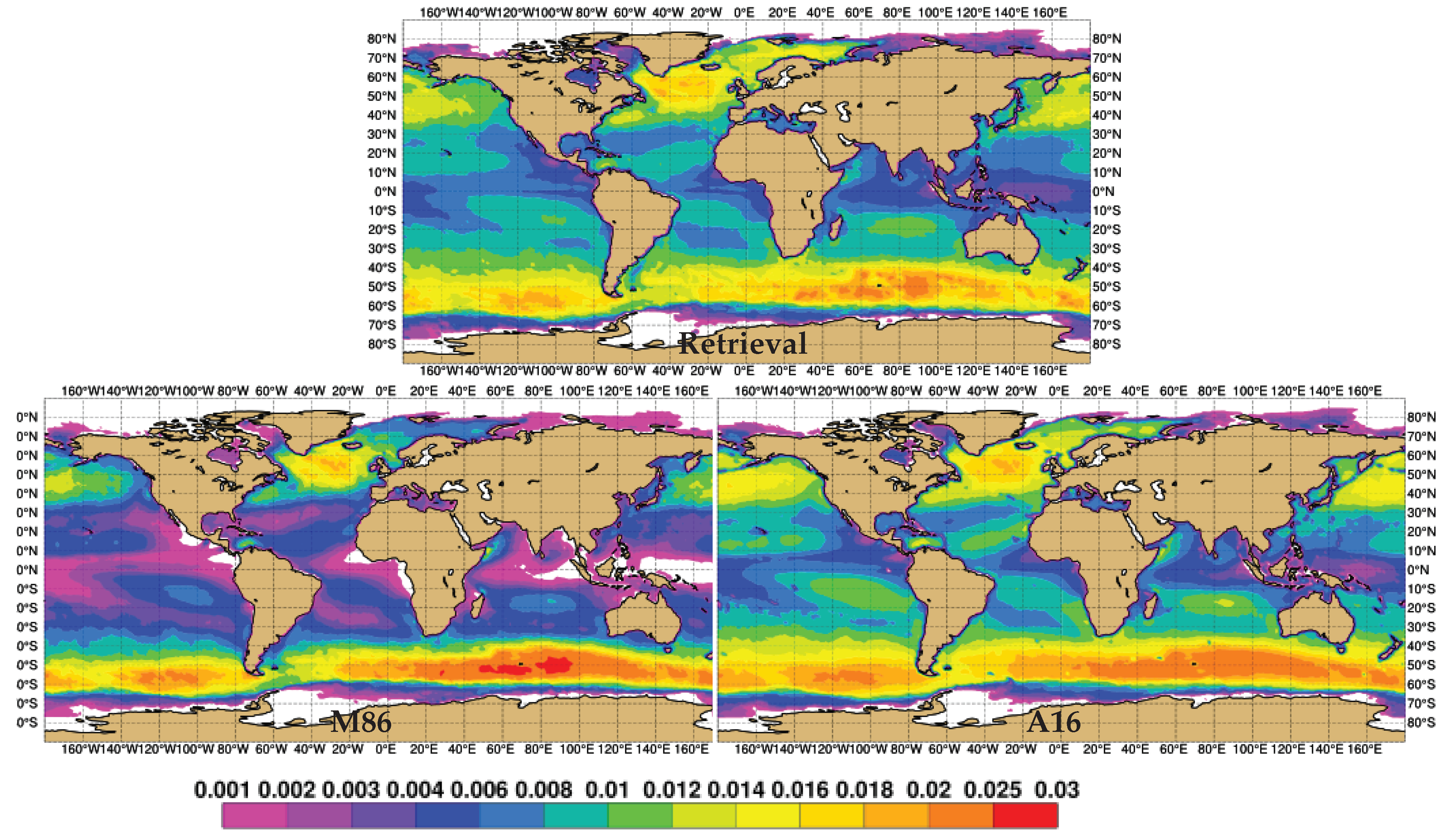
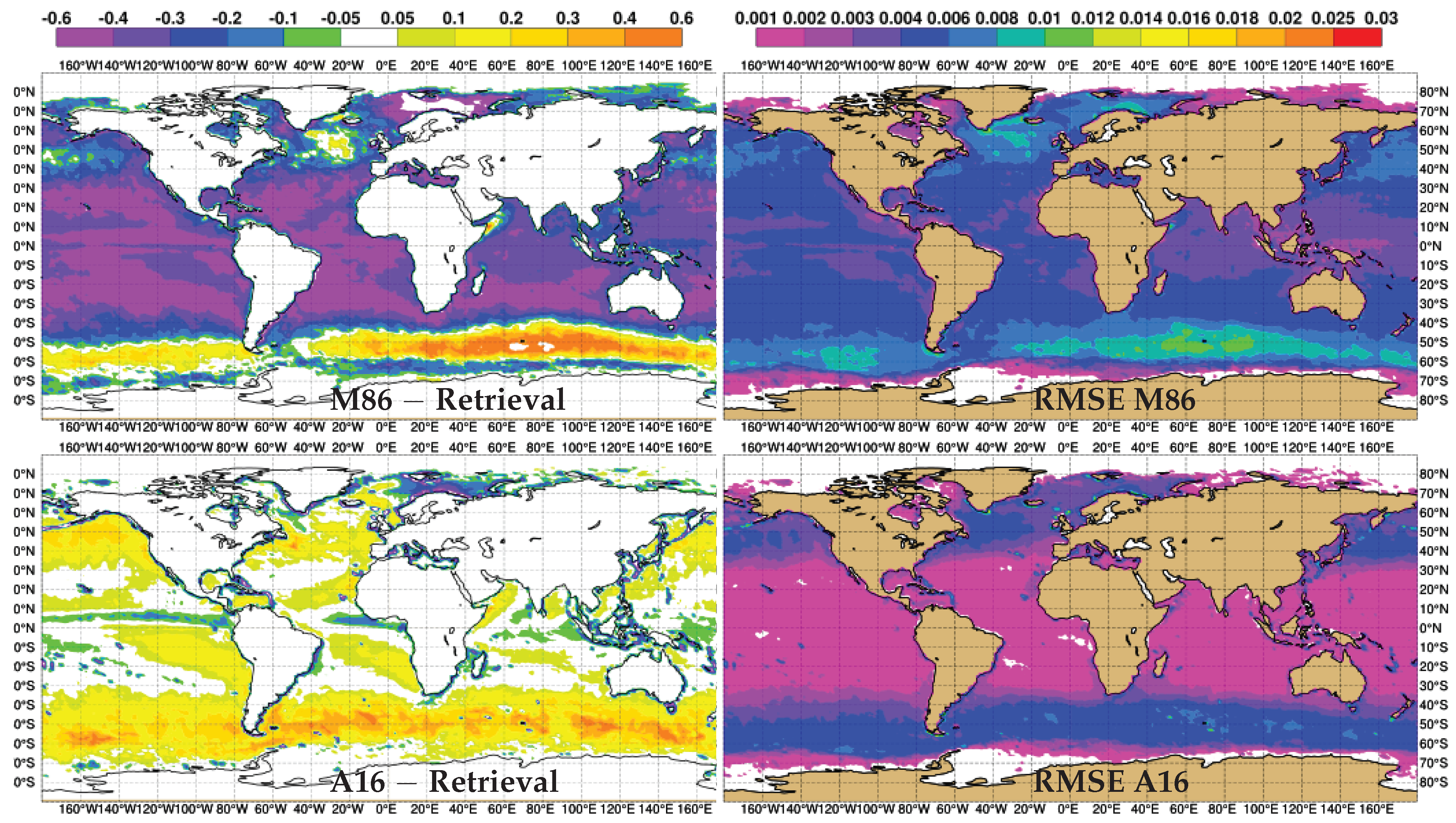

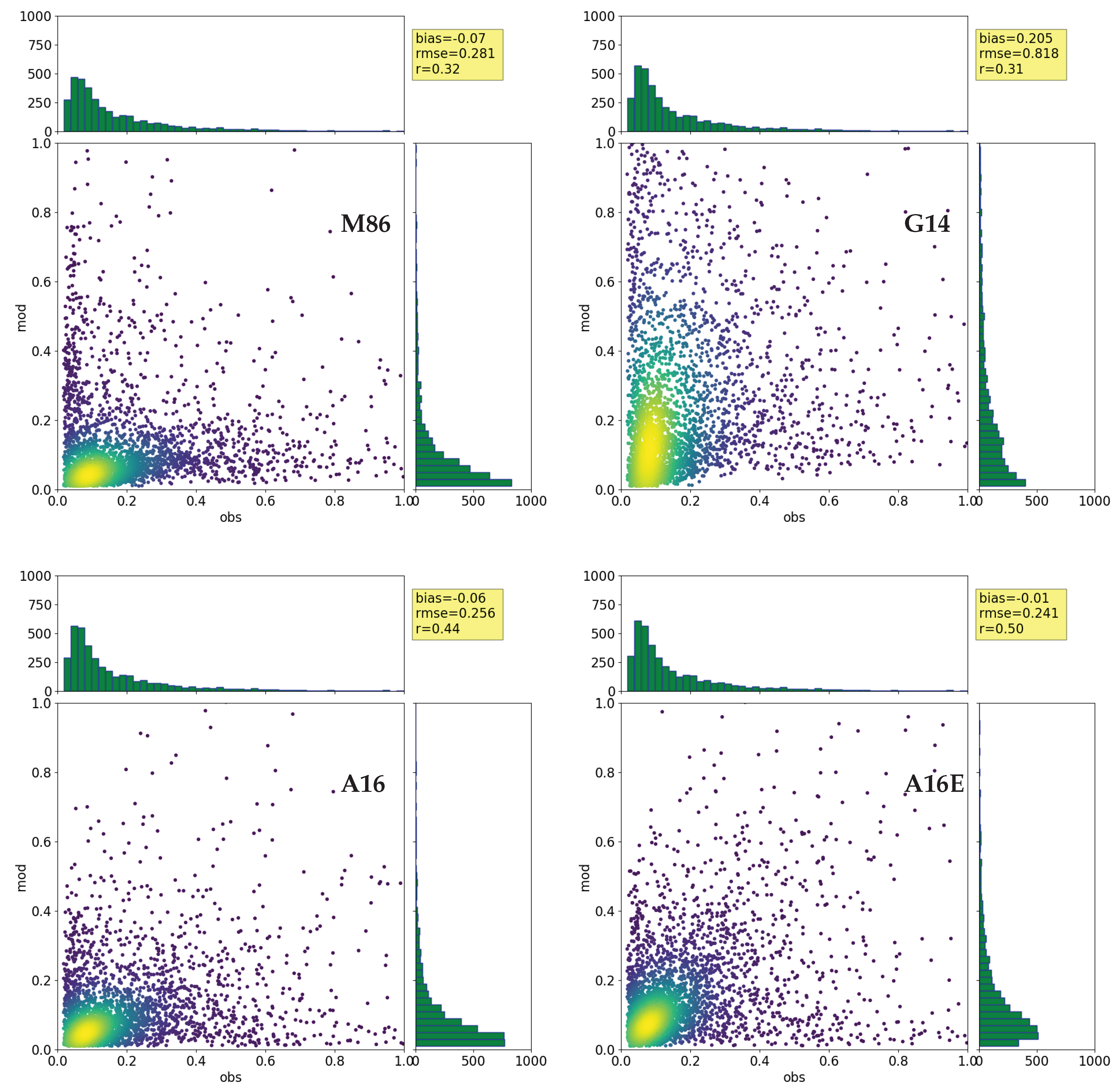
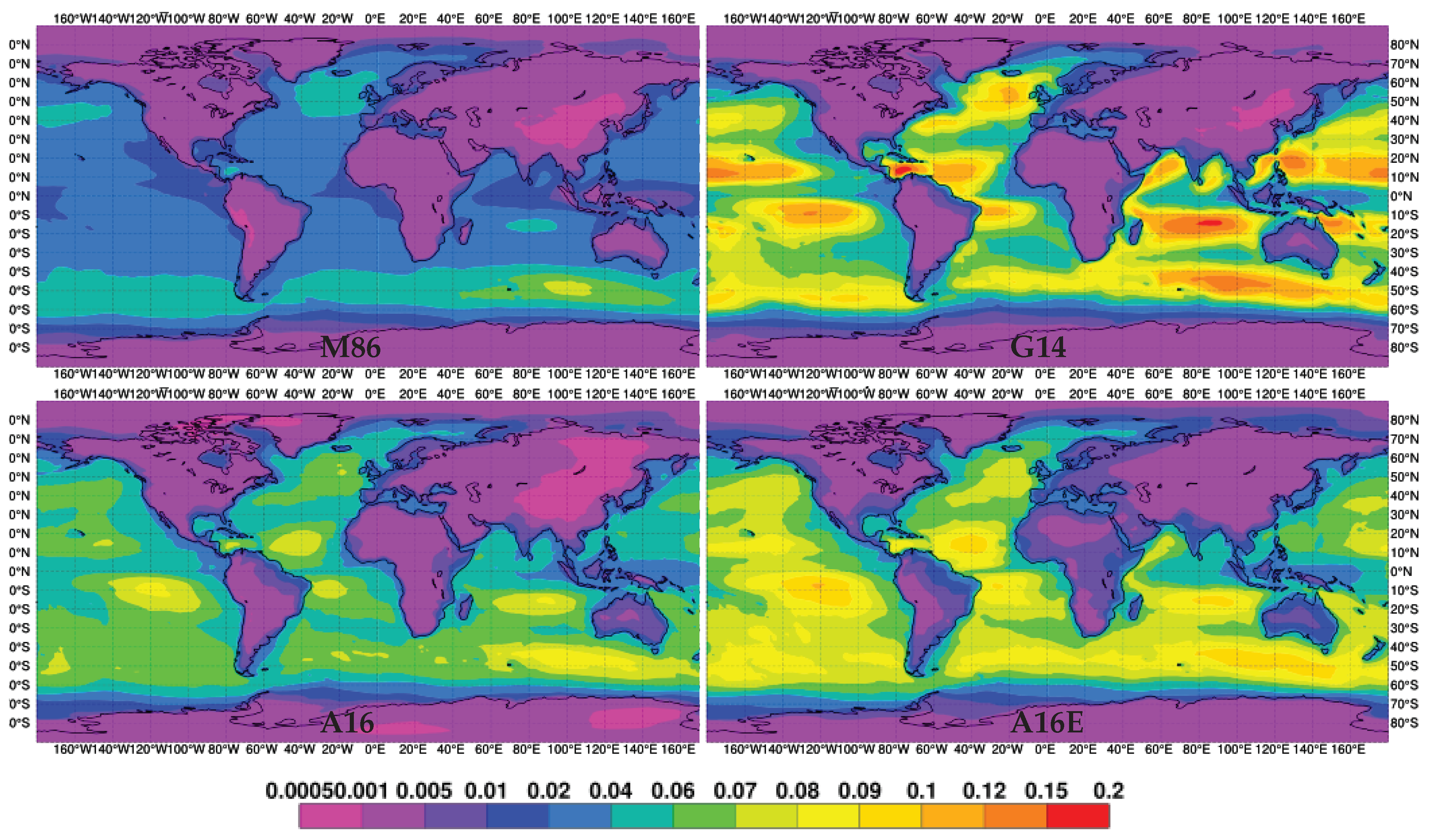

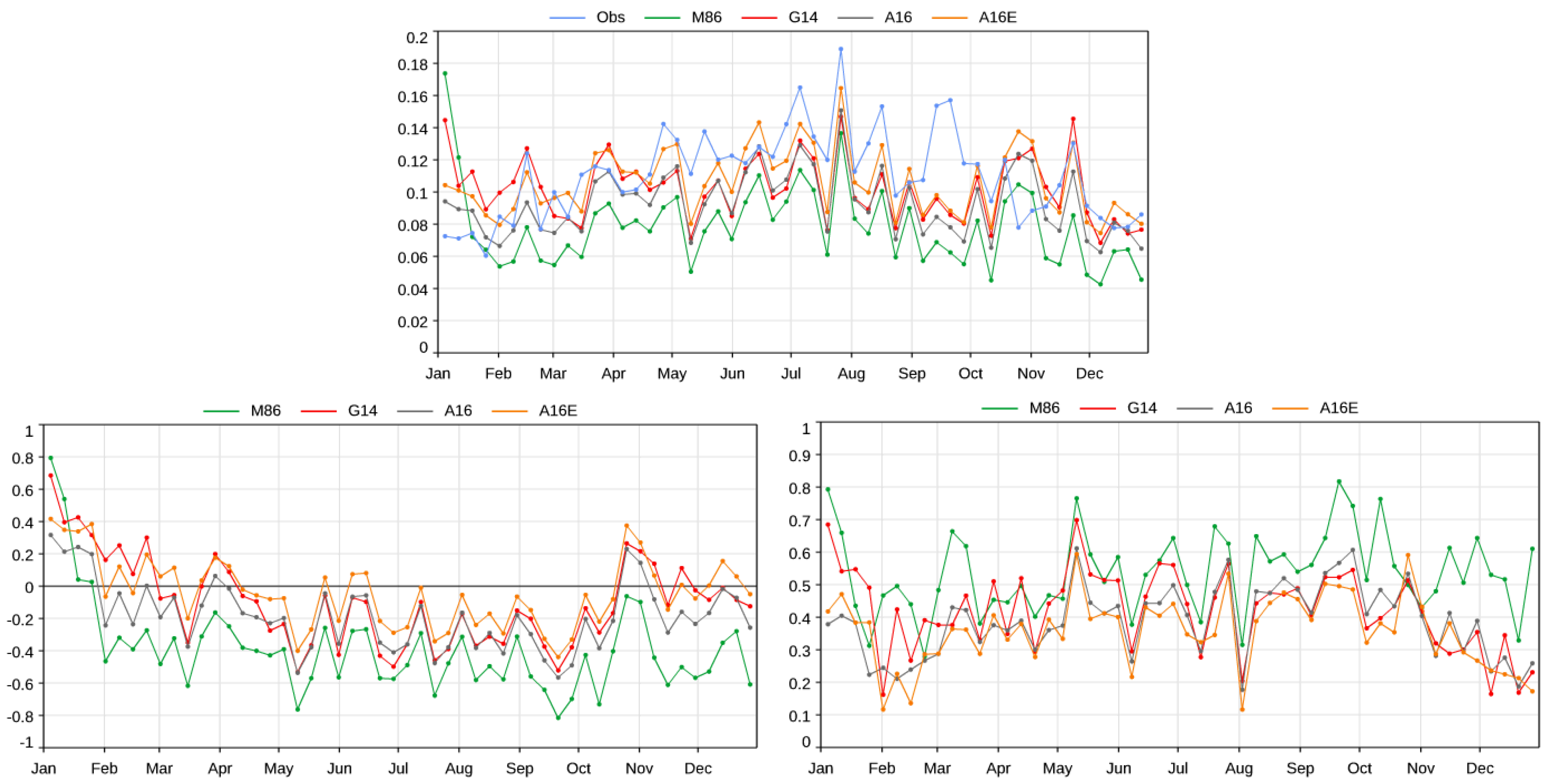
| Experiment | Operational Cycle | Scaling Factor | Shape Function | Size Range ( µm) |
|---|---|---|---|---|
| M86 | 43R3 | Equation (4) | Equations (2) and (3) | 0.8–8 |
| G14 | 45R1, 46R1 | Equation (6) | Equation (5) | 0.1–30 |
| A16 | 47R1 | Equations (7) and (8) | Equations (2) and (3) | 0.8–8 |
| A16E | NA | Equations (7) and (8) | Equations (9) and (10) | 0.07–20 |
| Process | Bin 1 | Bin 2 | Bin 3 | Total |
|---|---|---|---|---|
| Emissions (M86) | 32.2 | 2767.2 | 3363.8 | 6163.2 |
| Burden (M86) | 0.09 | 3.53 | 1.43 | 5.05 |
| Lifetime (M86) | 1.0 | 0.46 | 0.16 | 0.29 |
| Emissions (G14) | 41.6 | 1799.5 | 45,531.6 | 47,372.7 |
| Burden (G14) | 0.14 | 2.86 | 22.5 | 22.5 |
| Lifetime (G14) | 1.3 | 0.58 | 0.18 | 0.2 |
| Emissions (A16) | 110.3 | 6595.5 | 13,657.8 | 20,363.6 |
| Burden (A16) | 0.39 | 4.46 | 1.41 | 6.2 |
| Lifetime (A16) | 1.3 | 0.25 | 0.04 | 0.11 |
| Emissions (A16E) | 197.8 | 2444.6 | 9190.3 | 11,832.7 |
| Burden (A16E) | 0.7 | 3.45 | 1.87 | 6.02 |
| Lifetime (A16E) | 1.29 | 0.52 | 0.07 | 0.19 |
| Experiment | MNMB | FGE |
|---|---|---|
| M86 | −0.207 | 0.241 |
| G14 | −0.099 | 0.168 |
| A16 | −0.119 | 0.164 |
| A16E | −0.084 | 0.142 |
Publisher’s Note: MDPI stays neutral with regard to jurisdictional claims in published maps and institutional affiliations. |
© 2021 by the authors. Licensee MDPI, Basel, Switzerland. This article is an open access article distributed under the terms and conditions of the Creative Commons Attribution (CC BY) license (https://creativecommons.org/licenses/by/4.0/).
Share and Cite
Rémy, S.; Anguelova, M.D. Improving the Representation of Whitecap Fraction and Sea Salt Aerosol Emissions in the ECMWF IFS-AER. Remote Sens. 2021, 13, 4856. https://doi.org/10.3390/rs13234856
Rémy S, Anguelova MD. Improving the Representation of Whitecap Fraction and Sea Salt Aerosol Emissions in the ECMWF IFS-AER. Remote Sensing. 2021; 13(23):4856. https://doi.org/10.3390/rs13234856
Chicago/Turabian StyleRémy, Samuel, and Magdalena D. Anguelova. 2021. "Improving the Representation of Whitecap Fraction and Sea Salt Aerosol Emissions in the ECMWF IFS-AER" Remote Sensing 13, no. 23: 4856. https://doi.org/10.3390/rs13234856
APA StyleRémy, S., & Anguelova, M. D. (2021). Improving the Representation of Whitecap Fraction and Sea Salt Aerosol Emissions in the ECMWF IFS-AER. Remote Sensing, 13(23), 4856. https://doi.org/10.3390/rs13234856





